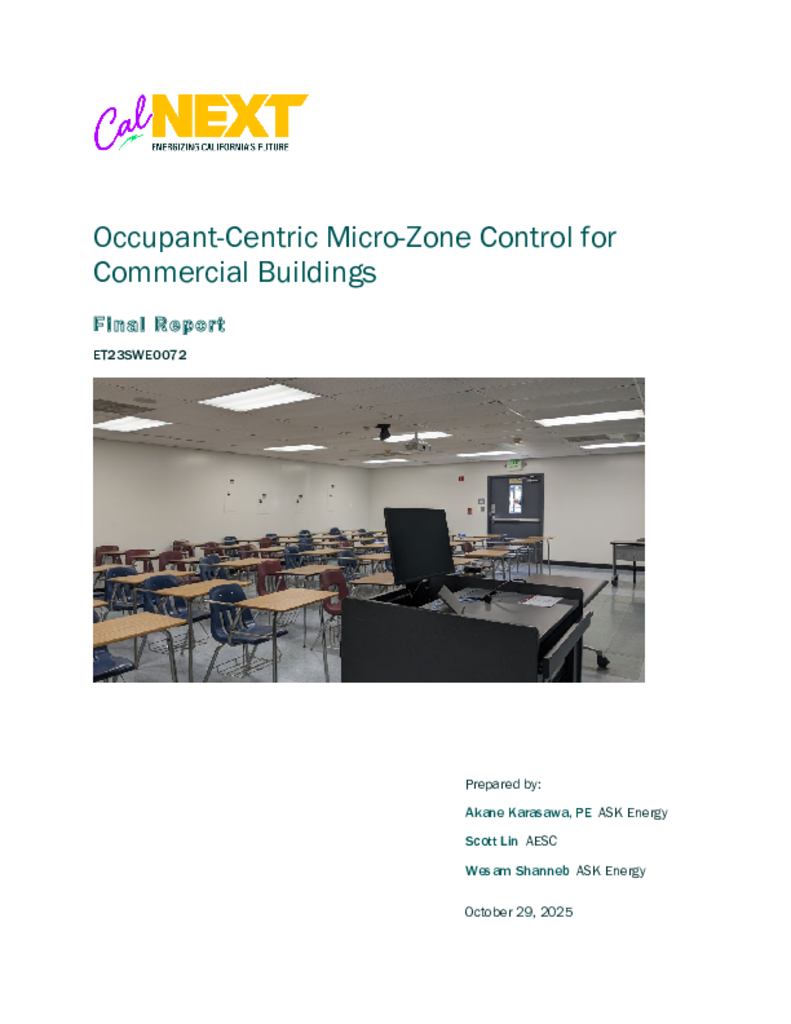ET23SWE0072 - Occupant-Centric Micro-Zone Control for Commercial Buildings
The proposed project involves field demonstration and evaluation of an emerging technology, which is micro-zone control for ducted variable air volume (VAV) systems in medium to large commercial buildings. The technology is the only commercially available product in the U.S. today that can be added onto and work with existing BMS and HVAC equipment. It uses advanced sensors and smart dampers to modulate airflow into each individual space (micro-zone) in a zone. The advanced sensors monitor temperature and humidity for occupant comfort; infrared, light, sound, and Bluetooth beacon for space occupancy; as well as CO2 and volatile organic chemicals (VOC) for air quality in each space. The technology then uses machine learning to analyze the sensor data and history to predict space occupancy at the micro-zone level, which is then used to control the damper to modulate ventilation as well as cooling/heating provided to the space. The technology’s machine learning can be tied to scheduling and is up to optimal learning patterns after 8-10 weeks.
Energy savings are obtained by reducing the amount of conditioned airflow going into unoccupied spaces in both cooling and heating modes. With the traditional VAV system, the minimum ventilation and conditioned airflow is determined based on the occupancy at the zone level. In comparison, the emerging technology can further reduce the ventilation and conditioned air flow because the occupancy is determined at micro-zone level. When the demand for conditioned air is reduced, the energy consumptions of the AHU fan as well as the central plant equipment (chiller/boiler) are also reduced, resulting in energy savings. The manufacturer reported that a past installation showed to save over 36% in HVAC energy usage while only being installed on 30% of a building. In addition, the technology solves the hot office and cold office issues that are usually the result of the over-conditioning of occupied spaces by enabling micro-zone level temperature control. Moreover, the technology continuously monitors CO2, VOC, PM 2.5 to make sure adequate amount of ventilation is provided to each space when the space is occupied, leading to a heathier workplace for occupants.
The filed performance of the micro-zone controls will be evaluated through M&V to show energy savings and occupant comfort over traditional VAV system.
Heating, ventilation, and air conditioning (HVAC) systems represent a major contributor to building energy consumption, yet conventional zone-based control strategies often fail to optimize airflow for dynamic occupancy patterns, leading to inefficiencies and compromised indoor air quality. Micro-zone control, an emerging technology, addresses this challenge by leveraging advanced sensors and smart dampers to enable real-time adjustments to ventilation, heating, and cooling, at a more granular level than traditional zone-based systems. Successful implementation of this approach could significantly reduce greenhouse gas emissions and support California’s climate and electrification goals.
This study evaluated the real-world performance of micro-zone control across different HVAC configurations and occupancy conditions. Field demonstrations were conducted at two Southern California Edison sites: a college campus building equipped with a variable air volume system and a single-zone rooftop unit retrofitted for micro-zone control. Testing spanned 11 months at the first site and six months at the second, with data analysis incorporating regression modeling and California Climate Zone 8 weather files to estimate annual energy impacts. Based on field test data, annual electricity savings were estimated at 38% for Site 1 and 9% for Site 2. These results indicate that micro-zone control can reduce electricity consumption and peak demand during low-occupancy periods, while improving indoor air quality through continuous monitoring of CO₂, volatile organic compounds, and particulate matter.
These findings highlight the potential for micro-zone control to enhance HVAC system performance, delivering both energy savings and healthier indoor environments. Broader adoption, supported by utility pilot programs and integration with Networked Lighting Controls, could accelerate market penetration and contribute to statewide energy and climate objectives, positioning micro-zone control as a scalable solution for advanced building energy management.

